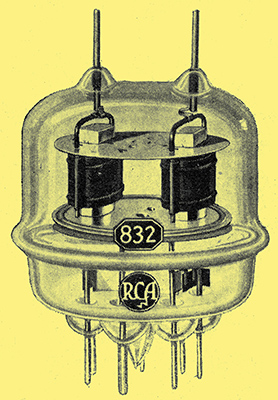|
Ultra-high Frequency 'Doorknob' Valve.

The general arrangement of the RCA-832 is clearly shown in this photograph.
A piece of apparatus described at the IRE convention was another member of the growing family of UHF doorknob tubes. The earlier members of the tribe have been due to the Western Electric Company, and have been of both triode and pentode form, some with a single unit, others push-pull in the, same bulb, and in a few instances the same element has been brought out at both ends of the bulb.
However, the latest variety, which is due to Radio Corporation of America, differs from all of these in that the twin pentodes are of the beam variety (beam tetrode) and especially because the screen-bypass capacitor is at last placed inside the tube, where it has long belonged. These features permit the full amplifier-output of 22 Watts (telegraphy) or 12 Watts (telephone carrier) to be obtained at wavelengths as short as 2 metres, after which the output drops rather rapidly, falling off 50% at 1 metre, which is the shortest wavelength for which the tube is rated, though self-oscillation is possible somewhat beyond.
The anode voltage is 400 or 325 for telegraph and telephone outputs as above, and the screens may be supplied from the same source through a 7,500 Ω resistor which serves both screens. The grid bias of -60 Volts (telegraphy) or -50 Volts (telephony) may be obtained in the usual manner. In the foregoing it is assumed that plate-modulation is to be used. However, for UHF work it is sometimes convenient to employ grid-modulation and to accept a lower percentage of modulation, and a reduced carrier power. Here the RCA 832 gives an exceptionally good performance. With anode and screen voltages of 400 and 250 respectively there can be obtained a carrier power of somewhat more than 7 Watts capable of acceptable 70% grid-bias modulation. In this case the screen voltage must be fixed, but bias may be taken from a 1 kΩ cathode resistor.
In all of the applications mentioned the driving requirements are modest, falling below 0.2 Watt in all cases. In the demonstration before the Institute an 832 doorknob drove a 10 Watt Mazda lamp well above normal brilliancy when its own grid was driven by a receiving 'acorn' valve operating on quite low voltages. The output ceased when the acorn was switched off, showing that proper amplification was occurring.
The glass doorknob body measures about 2 in each way, but the anode pins at one end and the other terminals at the opposite end raise the overall length to about 3½in. Incidentally, this terminal arrangement is very convenient when the valve is to be used with one pair of parallel rods connected to the anodes and another pair to the grids, the plate supply and grid return being connected to the corresponding short-circuiting bridges of these rod-pairs. The driver may be coupled magnetically to the resulting grid loop and the load either coupled to the anode loop magnetically or tapped to the anode rods through stopping capacitors in the conventional way.
The construction of the RCA-832 is best described by the accompanying photograph, which is due to the manufacturers, RCA Radiotron Division, RCA Manufacturing Co.
|